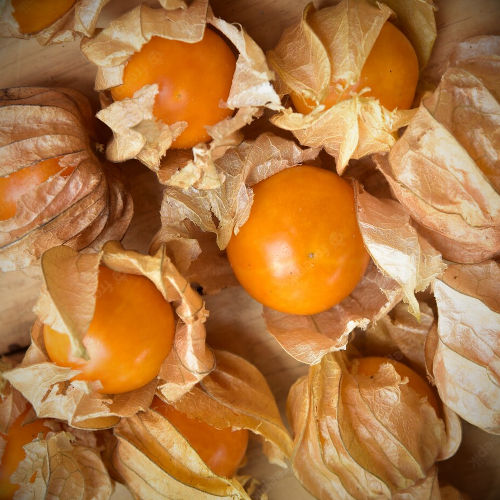The Cape gooseberry plant, scientifically known as Physalis peruviana, is a small perennial shrub native to the Andean region of South America. It is also commonly referred to as goldenberry, Peruvian groundcherry, or Inca berry. Here are the characteristics, uses, and benefits associated with the Cape gooseberry plant: Characteristics:
- Growth Habit: The Cape gooseberry plant typically grows to a height of 60 to 90 centimeters. It has a sprawling, bushy growth habit with multiple branches.
- Fruit Appearance: The fruit of the Cape gooseberry is small and round, enclosed in a papery husk called a calyx. When fully ripe, the fruit is golden-yellow in colour and resembles a small cherry tomato.
- Flavour and Taste: Cape gooseberries have a unique flavour profile. They are slightly tart, sweet, and tangy, with hints of tropical and citrus flavours. The taste is often described as a combination of pineapple, mango, and tomato.
Uses and Benefits:
- Culinary Uses: Cape gooseberries are primarily used in culinary applications. They can be eaten fresh as a snack or used in both sweet and savoury dishes. They are commonly used in salads, desserts, jams, chutneys, and sauces. Cape gooseberries can also be used in pies, tarts, and smoothies, adding a unique flavour and texture.
- Nutritional Value: Cape gooseberries are rich in various nutrients. They are a good source of vitamin C, vitamin A, and antioxidants. They also provide dietary fibre and contain minerals like potassium and phosphorus.
- Medicinal Potential: In traditional medicine, Cape gooseberries have been used for their potential health benefits. They are believed to have anti-inflammatory properties and may help boost the immune system. However, scientific research on their specific medicinal properties is limited, and it's always advisable to consult a healthcare professional before using them for any medicinal purposes.
- Culinary Garnish: The attractive appearance of Cape gooseberries, with their bright golden hue and papery husks, makes them a popular choice for garnishing dishes. They can add visual appeal to salads, desserts, and cocktails.
- Ornamental Plant: Apart from their culinary uses, Cape gooseberry plants are often grown as ornamentals. The vibrant fruit and unique husks make them visually appealing additions to gardens and container plantings.
- Easy to Grow: Cape gooseberry plants are relatively easy to grow, making them suitable for home gardeners. They prefer full sun or partial shade and well-draining soil. They can be grown from seeds or transplants, and with proper care, they can produce abundant fruit.
It's important to note that while Cape gooseberries are generally safe to consume, some individuals may have allergies or sensitivities to them. Additionally, the green parts of the plant, including the leaves, are toxic and should not be consumed. It's always advisable to harvest and consume fully ripe fruits and consult reliable sources or experts for guidance on safe consumption and cultivation practices.

